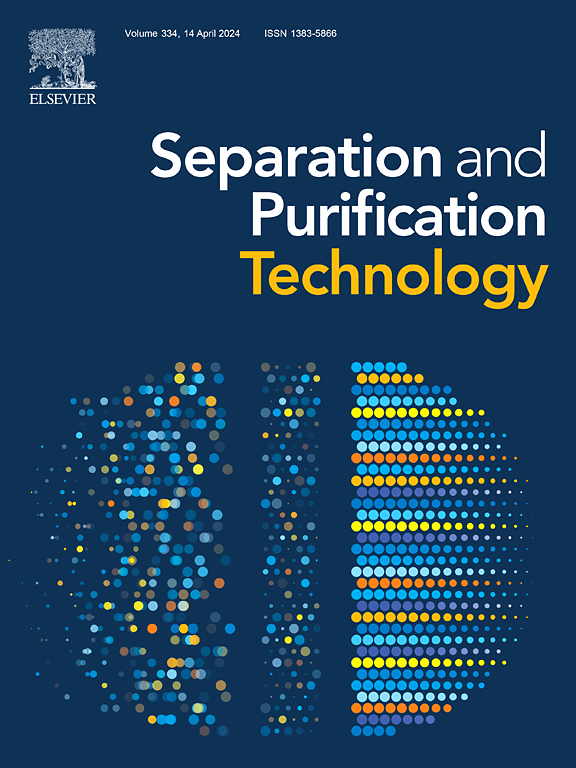铁掺杂钼酸镍纳米棒的氧空位工程加速电子转移以快速去除有机污染物
IF 8.1
1区 工程技术
Q1 ENGINEERING, CHEMICAL
引用次数: 0
摘要
铁掺杂金属氧化物在类芬顿反应中得到了广泛的应用。然而,Fe3+/Fe2+循环转化缓慢,不可避免地形成铁泥,限制了其应用。本文首次制备了具有杂原子金属位和富氧空位(Ov)的fe掺杂NiMoO纳米棒作为新型非均相催化剂(Ni/FeNi3-NiMoO)。Ni/FeNi3-NiMoO可以通过过氧单硫酸盐(PMS)活化在5 min内快速降解有机污染物,包括四环素、双酚A、环丙沙星、磺胺甲恶唑和罗丹明B。Ni/FeNi3-NiMoO纳米棒的催化速率常数为0.482 min−1,是NiMoO的371倍,超过了之前报道的铁基催化剂。此外,Ni/FeNi3-NiMoO膜反应器具有良好的适应性,耐久性超过10 h,并且具有高效的有机污染物氧化能力。猝灭实验和电子顺磁共振结果表明,羟基自由基是Ni/FeNi3-NiMoO/PMS体系中主要的活性氧,对Ni/FeNi3-NiMoO/PMS体系的贡献为79.3% %。催化机理验证了Mo/Ni位点与丰富的Ov的协同作用促进了电子传递速度,使Fe3+/Fe2+快速循环,从而促进了PMS的活化。这项工作为加速类芬顿反应中的Fe3+/Fe2+循环提供了有价值的见解。本文章由计算机程序翻译,如有差异,请以英文原文为准。

Oxygen vacancies engineering in iron-doped nickel molybdate nanorods to accelerate electron transfer for rapid organic pollutants removal
Iron-doped metal oxides have been widely used in Fenton-like reactions. However, sluggish conversion of Fe3+/Fe2+ circulation for inevitably forming iron sludge limits its applications. Herein, Fe-doped NiMoO nanorods with heteroatomic metal sites and rich oxygen vacancies (Ov) were prepared for the first time as novel heterogeneous catalysts (Ni/FeNi3-NiMoO). The Ni/FeNi3-NiMoO could rapidly degrade organic pollutants including tetracycline, bisphenol A, ciprofloxacin, sulfamethoxazole, and rhodamine B in 5 min via peroxymonosulfate (PMS) activation. The Ni/FeNi3-NiMoO nanorods achieved a remarkable catalytic rate constant of 0.482 min−1, which was 371-fold higher than that of NiMoO and surpassed previously reported Fe-based catalysts. Besides, the Ni/FeNi3-NiMoO membrane reactor exhibited good adaptability, durability over 10 h, and efficient organic pollutants oxidation capacity. Hydroxyl radical was the primary reactive oxygen species by quenching experiments and electron paramagnetic resonance, which contributed 79.3% in the Ni/FeNi3-NiMoO/PMS system. A catalytic mechanism verified that the synergistic effect of Mo/Ni sites and rich Ov promoted the electron transport speed for a rapid Fe3+/Fe2+ cycle to boost PMS activation. This work provides valuable insights into Fe-doped metal oxides for accelerating the Fe3+/Fe2+ cycle in Fenton-like reactions.
求助全文
通过发布文献求助,成功后即可免费获取论文全文。
去求助
来源期刊

Separation and Purification Technology
工程技术-工程:化工
CiteScore
14.00
自引率
12.80%
发文量
2347
审稿时长
43 days
期刊介绍:
Separation and Purification Technology is a premier journal committed to sharing innovative methods for separation and purification in chemical and environmental engineering, encompassing both homogeneous solutions and heterogeneous mixtures. Our scope includes the separation and/or purification of liquids, vapors, and gases, as well as carbon capture and separation techniques. However, it's important to note that methods solely intended for analytical purposes are not within the scope of the journal. Additionally, disciplines such as soil science, polymer science, and metallurgy fall outside the purview of Separation and Purification Technology. Join us in advancing the field of separation and purification methods for sustainable solutions in chemical and environmental engineering.
 求助内容:
求助内容: 应助结果提醒方式:
应助结果提醒方式:


